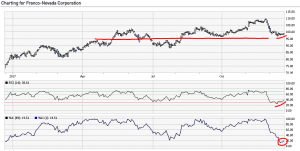Profiting on a higher share price for Franco-Nevada Corp.

As you can see in the following graph, the price of shares in Franco Nevada Corp. (FNV) appears to have stabilized at around $99, just above the $95 support level, after having fallen almost systematically since November 28 when it peaked at $110.18. This decline pushed the stochastic oscillator, shown at the bottom of the graph, into oversold territory, while the RSI (Relative Strength Index) indicator rose out of its own oversold zone. This situation could signal the start of a rally of unknown strength and length. In the absence of a price objective, it is usually good practice to sell put options in order to benefit from the time decay. Since this strategy has been covered in prior articles, here we will look at buying call options in lieu of the underlying shares.
Daily Chart of FNV

As we know, the purchase of call options, and options in general, is negatively affected by time decay. This is particularly true in the case of at-the-money options, whose strike price is equal to the share price. In fact, among all the options available, it is at-the-money options that have the most time value. So the investor who wants to limit the negative impact of time decay would avoid buying at-the-money call options and concentrate instead on options that contain the least time value possible. This group includes out-of-the money call options, whose strike price is higher than the share price, and in-the-money options, whose strike price is lower than the share price. We can begin by excluding out-of-the-money options: since we have neither a price objective nor a time interval in mind, they represent too great a risk of losing the entire premium paid. All that remains is in-the-money options. The more that an option is in the money, the less time value it has, and the more that price changes in the option will be correlated with price changes in the underlying share. This is precisely what we need. We want to profit from an increase in the share price while incurring the least possible negative impact of time decay. We are therefore looking for a compromise position between these two constraints.
For example, consider the following call options available when FNV is trading at $98.87 on December 20, 2017:
| FNV = $98.87 | Intrinsic value | Time value | Delta |
| 1. FNV 180420 C 92 at $10.05 | $6.87 | $3.18 | 0.72 |
| 2. FNV 180420 C 86 at $14.65 | $12.87 | $1.78 | 0.84 |
| 3. FNV 180420 C 80 at $20.00 | $18.87 | $1.13 | 0.91 |
Given the three call options shown above, it is option 3 (FNV 180420 C 80) that has the least time value ($1.13). Its delta of 0.91 (which can be obtained using the Montreal Exchange’s options calculator at https://m-x.ca/marc_options_calc_en.php) tells us that the price of this option is 91% correlated with the price of FNV. It is option 1 (FNV 180420 C 92) that has the most time value ($3.18), and with a delta of 0.72, its price is 72% correlated with the price of FNV. The time value of this option represents close to 50% of its premium, whereas the time value of option 3 represents less than 10%. Lastly, option 2 (FNV 180420 C 86) has a time value of $1.78 and is 84% correlated with the price of FNV. Moreover, the time value represents approximately 15% of its premium.
Given the fact that we do not have a price objective in mind nor a specific time interval, we should choose between options 2 and 3, or from among the options available between these two (but not discussed here). Consequently, our choice of one of these two options will be a compromise between the amount of time value, the option’s correlation with the price of FNV, and the price paid for the call option.
Intervention
Since we have no particular target price in mind, the decision on whether or not to sell the position and realize a profit will be based on any new information received from the market between now and April 20, 2018. However, if the price falls, we can immediately say that the support level of $95 should represent a stop level that, if broken through, should trigger the decision to sell the position at a loss.
Good luck with your trading, and have a good week!
The strategies presented in this blog are for information and training purposes only, and should not be interpreted as recommendations to buy or sell any security. As always, you should ensure that you are comfortable with the proposed scenarios and ready to assume all the risks before implementing an option strategy.
President
Monetis Financial Corporation
Martin Noël earned an MBA in Financial Services from UQÀM in 2003. That same year, he was awarded the Fellow of the Institute of Canadian Bankers and a Silver Medal for his remarkable efforts in the Professional Banking Program. Martin began his career in the derivatives field in 1983 as an options market maker for options, on the floor at the Montréal Exchange and for various brokerage firms. He later worked as an options specialist and then went on to become an independent trader. In 1996, Mr. Noël joined the Montréal Exchange as the options market manager, a role that saw him contributing to the development of the Canadian options market. In 2001, he helped found the Montréal Exchange’s Derivatives Institute, where he acted as an educational advisor. Since 2005, Martin has been an instructor at UQÀM, teaching a graduate course on derivatives. Since May 2009, he has dedicated himself full-time to his position as the president of CORPORATION FINANCIÈRE MONÉTIS, a professional trading and financial communications firm. Martin regularly assists with issues related to options at the Montréal Exchange.
The information provided on this website, including financial and economic data, quotes and any analysis or interpretation thereof, is provided solely for information purposes and shall not be construed in any jurisdiction as providing any advice or recommendation with respect to the purchase or sale of any derivative instrument, underlying security or any other financial instrument or as providing legal, accounting, tax, financial or investment advice. Bourse de Montréal Inc. recommends that you consult your own advisors in accordance with your needs before making decision to take into account your particular investment objectives, financial situation and individual needs.
All references on this website to specifications, rules and obligations concerning a product are subject to the rules, policies and procedures of Bourse de Montréal Inc. and its clearinghouse, the Canadian Derivatives Clearing Corporation, which prevail over the content of this website. Although care has been taken in the preparation of the documents published on this website, Bourse de Montréal Inc. and/or its affiliates do not guarantee the accuracy or completeness of the information published on this website and reserve the right to amend or review, at any time and without prior notice, the content of these documents. Neither Bourse de Montréal Inc. nor any of its affiliates, directors, officers, employees or agents shall be liable for any damages, losses or costs incurred as a result of any errors or omissions on this website or of the use of or reliance upon any information appearing on this website.
BAX®, CADC®, CGB®, CGF®, CGZ®, LGB®, MX®, OBX®, OGB®, OIS-MX®, ONX®, SCF®, SXA®, SXB®, SXF®, SXH®, SXM®, SXO®, SXY®, and USX® are registered trademarks of the Bourse. OBW™, OBY™, OBZ™, SXK™, SXJ™, SXU™, SXV™, Montréal Exchange and the Montréal Exchange logo are trademarks of the Bourse. All other trademarks used are the property of their respective owners.
© 2024 Bourse de Montréal Inc. All Rights Reserved.
